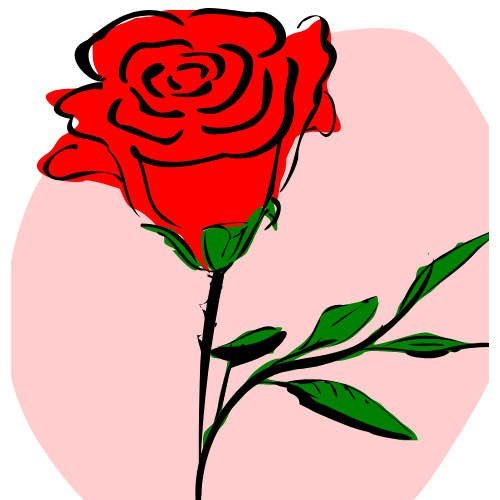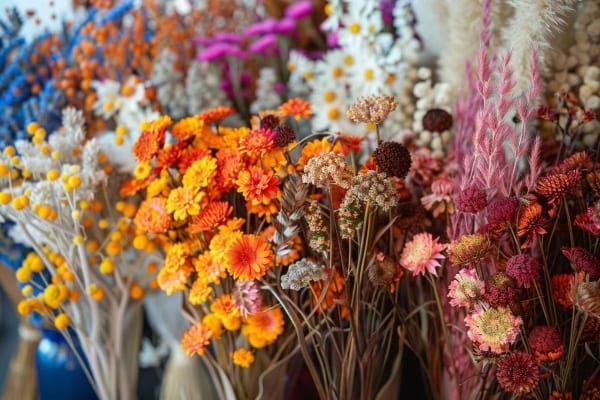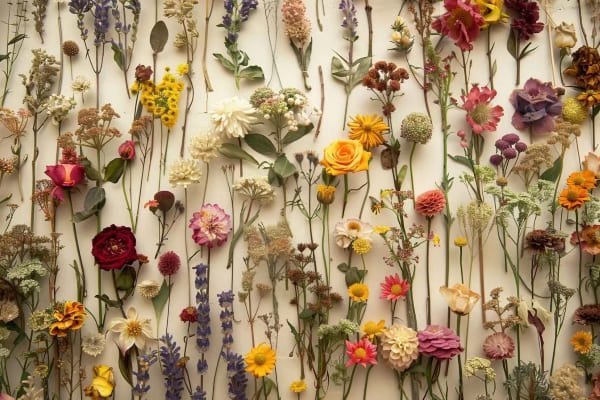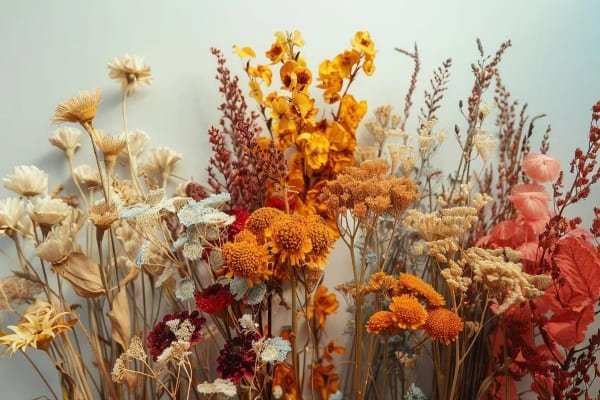Introduction
Dried flowers have become increasingly popular in recent years, making their way into a wide range of applications, from home decor to weddings and crafts. The appeal lies in their long-lasting beauty, versatility, and eco-friendly nature. However, with the vast array of dried flowers available on the market, choosing the right bulk dried flowers for your specific needs can be overwhelming. This guide will help you navigate the selection process, considering factors such as intended use, flower type, color, size, and budget. By the end, you’ll have a clear understanding of how to make informed decisions when purchasing bulk dried flowers.
Understanding Your Needs
The first step in choosing the right bulk dried flowers is to clearly define your needs. Understanding what you intend to do with the dried flowers will guide your selection process.
- Purpose of Purchase
- Decorative Use: If your primary purpose is to enhance home or office decor, you'll need flowers that complement your space’s existing style and color scheme.
- Events and Weddings: For events, especially weddings, the selection process involves choosing flowers that align with the theme, color palette, and mood you wish to create.
- Craft Projects: If you’re purchasing dried flowers for crafts, consider the specific projects you’ll be working on, such as wreath-making, card design, or floral art.
- Business Use: If you’re a florist, event planner, or run a craft business, consider the preferences of your target market and the trends within your industry.
- Volume Requirements
- Determine how much you need. Buying in bulk is cost-effective, but it’s important to estimate your requirements accurately to avoid waste or shortage.
- Consider storage space as well, since dried flowers must be stored properly to maintain their quality.
Types of Dried Flowers
Not all dried flowers are created equal, and understanding the different types available will help you make an informed choice.
- Air-Dried Flowers
- Description: Air-dried flowers are the most traditional type, where flowers are hung upside down in a dry, dark place to dehydrate naturally.
- Pros: Retain much of their original color and shape, environmentally friendly, and affordable.
- Cons: Some air-dried flowers may become brittle over time, and color may fade faster than other preservation methods.
- Best Use: Ideal for rustic and vintage-themed decor, crafts, and arrangements where a natural look is desired.
- Preserved Flowers
- Description: Preserved flowers are treated with a solution that replaces the natural sap, keeping the flowers soft and flexible.
- Pros: Long-lasting, retains color and texture better than air-dried flowers, and looks more like fresh flowers.
- Cons: Typically more expensive than air-dried flowers and may contain chemicals.
- Best Use: Suitable for high-end decor, bridal bouquets, and where a more vibrant, fresh appearance is required.
- Silica-Dried Flowers
- Description: Silica gel is used to dry flowers quickly, preserving their color and structure.
- Pros: Retains color and shape exceptionally well, faster drying process.
- Cons: Can be more expensive and requires careful handling as flowers can be brittle.
- Best Use: Best for delicate projects like jewelry making, shadow boxes, and other crafts requiring intricate details.
- Pressed Flowers
- Description: Flowers are pressed between sheets of paper or in a flower press to dry flat.
- Pros: Ideal for a wide range of craft projects, retains color well, and can be used in flat compositions like art, cards, and bookmarks.
- Cons: Limited to flat projects and may not be suitable for three-dimensional arrangements.
- Best Use: Perfect for scrapbooking, card making, and framed artwork.
Color Considerations
The color of dried flowers plays a crucial role in how they will be used in your project or decor. Here’s how to choose the right colors:
- Matching Your Palette
- Neutral Tones: For a timeless and versatile look, opt for neutral tones like ivory, beige, or soft pastels. These colors blend well with various themes and decor styles.
- Bold Colors: Bright and bold colors like deep reds, purples, and yellows can make a statement and are ideal for accent pieces or focal points in arrangements.
- Monochrome: For a minimalist or modern aesthetic, choosing flowers in a single color can create a cohesive and elegant look.
- Seasonal Hues: Consider the season when choosing colors. For instance, warm tones like oranges and browns are perfect for fall, while cool blues and whites suit winter themes.
- Color Fastness
- Ensure that the dried flowers you choose have good color fastness, meaning they won’t fade quickly over time. Preserved and silica-dried flowers typically have better color retention.
Size and Shape
The size and shape of the dried flowers will affect how they fit into your design.
- Large Blooms
- Examples: Sunflowers, hydrangeas, and roses.
- Best Use: Large blooms are perfect as centerpieces or focal points in arrangements. They can stand alone or be paired with smaller flowers for contrast.
- Small Blooms
- Examples: Baby’s breath, lavender, and billy balls.
- Best Use: These are great for adding texture and filling in gaps in arrangements. They’re also ideal for smaller projects like boutonnieres, hair accessories, or wreaths.
- Foliage and Grasses
- Examples: Eucalyptus, pampas grass, and wheat.
- Best Use: Foliage and grasses add volume and a natural, organic feel to arrangements. They’re perfect for creating depth and layering in bouquets, wreaths, and wall hangings.
Quality Indicators
When buying dried flowers in bulk, it’s crucial to ensure you’re getting quality products. Here’s what to look for:
- Condition of the Flowers
- Intact Petals and Leaves: Check that the flowers have intact petals and leaves, without any signs of tearing or excessive brittleness.
- No Mold or Mildew: Ensure that the flowers are completely dry and free from any mold, mildew, or moisture damage.
- Consistent Color: Look for consistent coloring without significant fading or discoloration.
- Packaging
- Proper Packaging: Dried flowers should be packaged in a way that protects them during transit. Look for suppliers that use secure, cushioned packaging to prevent crushing.
- Eco-Friendly Options: Consider suppliers who use eco-friendly packaging materials, especially if sustainability is a priority for you.
- Supplier Reputation
- Research Suppliers: Choose suppliers with positive reviews and a good reputation for quality and reliability. Look for testimonials, ratings, and customer feedback.
- Samples: If possible, request samples before making a bulk purchase to assess the quality firsthand.
Sustainability Considerations
With growing awareness of environmental issues, sustainability is an important factor when choosing dried flowers.
- Ethically Sourced Flowers
- Choose suppliers that source their flowers ethically, supporting fair labor practices and sustainable farming methods.
- Organic Options
- Organic dried flowers are grown without synthetic pesticides or fertilizers, making them a better choice for the environment and for consumers who prioritize natural products.
- Eco-Friendly Preservation Methods
- Opt for dried flowers that have been preserved using eco-friendly methods, such as air-drying or using biodegradable preservatives.
Budget Considerations
While buying in bulk can be cost-effective, it’s important to balance quality with budget constraints.
- Price vs. Quality
- Don’t compromise too much on quality for the sake of saving money. Poor-quality flowers may not look as good and could lead to additional costs if replacements are needed.
- Bulk Discounts
- Look for suppliers who offer discounts for bulk purchases. Some may offer tiered pricing based on the quantity purchased.
- Hidden Costs
- Be aware of any hidden costs, such as shipping fees or taxes, that could affect your overall budget. Some suppliers may offer free shipping for bulk orders, which can be a significant saving.
Practical Tips for Buying in Bulk
Here are some practical tips to keep in mind when purchasing bulk dried flowers:
- Plan Ahead
- Plan your purchase well in advance, especially if you’re buying for an event or specific project. This allows you to take advantage of discounts and ensures availability.
- Storage Solutions
- Ensure you have a suitable storage solution for your bulk purchase. Dried flowers should be stored in a cool, dry place away from direct sunlight to maintain their quality.
- Mix and Match
- Don’t be afraid to mix and match different types of dried flowers to create unique and diverse arrangements. This can also help you stay within budget while adding visual interest to your projects.
Conclusion
Choosing the right bulk dried flowers for your needs involves careful consideration of several factors, including the type of flowers, their color, size, and quality, as well as your intended use and budget. By understanding your specific requirements and following the guidelines outlined in this article, you can confidently select the best dried flowers for your projects, whether for home decor, events, crafts, or business. With the right selection, your dried flower arrangements will be beautiful, long-lasting, and perfectly suited to your needs.




